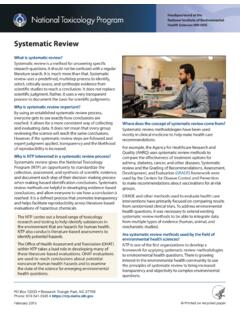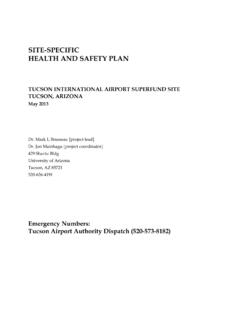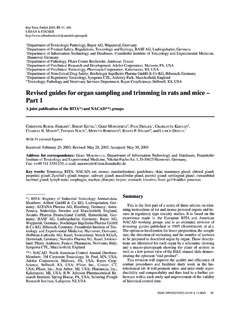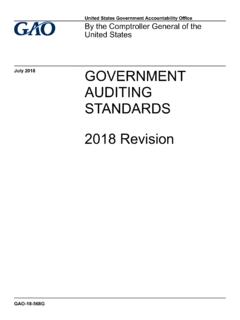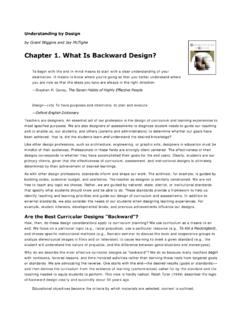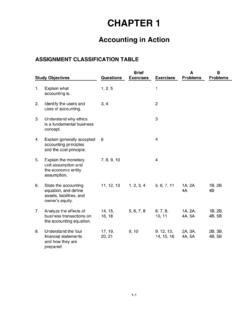Transcription of Chapter 7: Principles of Evaluation
1 Partnerships for Environmental Public Health Evaluation Metrics Manual Chapter 7: Principles of Evaluation Chapter Contents Introduction .. Logic Models .. Types of Evaluations .. Planning an 200 202 208 209 199 200 Principles of Evaluation Chapter 7: Principles of Evaluation Introduction In previous chapters, we provide information about how to develop Evaluation metrics for specific aspects of environmental public health programs. This Chapter provides an overview of basic Evaluation Principles , including: Logic models Types of evaluations Components of Evaluation plans Readers can apply these Principles in the planning and implementation of their environmental public health programs to ensure that they are able to document and publicize their successes. Why evaluate? Evaluation involves the systematic collection of information about the activities, characteristics, and outcomes of programs, personnel, and reduce uncertainties, improve effectiveness, and make decisions with regard to what those programs, personnel, or products are doing and affecting.
2 65 The benefits of evaluations include the ability to: Assess effectiveness and impact. Determine factors that lead to program success (or failure). Identify areas for program improvement. Justify further funding. Identify new audiences and applications for projects. When to evaluate? Evaluations may be undertaken at any time, and they are generally most effective when they are conducted as an integral aspect of the program. Evaluations that are conducted throughout a project s lifespan can provide opportunities for program improvement as the program is evolving rather than after it is complete. Ongoing evaluations also provide an opportunity to adapt the evaluations to address project goals and objectives that may have changed over time. During certain points in a project s lifecycle, there is value in stepping back to examine more fully the operations or impacts of the project.
3 Choosing the right timing depends on the specifics of the project and its particular context. Grantees will likely need to balance many factors, including the Evaluation purpose, scale, cost, and program resources, when thinking about the timing of an Evaluation . 65 Patton MQ. 1982. Practical Evaluation . Beverly Hills, CA: Sage Publications, Inc. 15. Principles of Evaluation : Introduction 201 Principles of Evaluation Metrics in Action : The Detroit Community-Academic Urban Research Center (URC) incorporates evaluations into its overall program planning and development activities. The Detroit URC links a university, eight community-based organizations, a city health department, and a health care system to identify problems affecting the health of residents of Detroit, Michigan. The partners also promote and conduct interdisciplinary research, which assesses, leverages, and enhances the resources and strengths of the communities involved.
4 The URC Board conducts its work in accordance with a set of Community-Based Participatory Research (CBPR) Principles adopted by the URC Board that foster, for example, equal participation by all partners in all aspects of the Center s activities and recognition that community-based participatory research is a collaborative process that is mutually beneficial to all partners involved. The 15-member board provides leadership for the group and annually evaluates the partnership and its activities in order to assess the extent to which the partnership is following its key Principles of collaboration, participation, and equity. The board uses the Evaluation findings to build on successes of the program and to share outputs and short-term outcomes with partners. In addition, the findings often lead to changes in board activities, policies, or research focus.
5 Conducting annual evaluations allows the Detroit URC to be responsive to short-term changes and to work toward the best possible outcomes. Ethical considerations Because PEPH researchers and evaluators often interact with the community and solicit personal information, it is advisable that they understand their legal and moral obligations to human subjects who participate in research and the Evaluation of that research. This understanding can lead to greater trust by their partners and fewer conflicts or misunderstandings down the road. Partners can become familiar with the Principles of:66 Ethics Confidentiality Accountability Competency Relevancy Objectivity Independence For example, university researchers must comply with federal laws and follow the guidelines set out by their institutional review boards (IRBs).67 When publicizing Evaluation findings, partners must remember to keep sensitive information confidential and protect the identities of their subjects.
6 66 For more information, see also, Government Accountability Office (GAO). 2007. Government Auditing Standards, July 2007 Revision. Available: [accessed 19 January 2021]; American Evaluation Association (AEA). 2004. Guiding Principles for Evaluators. 67 Penslar RB, Porter JP. 1993. Office for Human Research Protections (OHRP) IRB Guidebook. United States Department of Health and Human Services (HHS). Available: [accessed 19 January 2021]. Principles of Evaluation : Introduction 202 Principles of Evaluation Logic Models This Manual makes extensive use of logic models as an approach to developing metrics. A logic model presents a plausible and sensible model of how the program will work under certain conditions to solve identified problems. 68 It is a framework for showing the relationship between the activities a project conducts and the ultimate impacts or outcomes it achieves.
7 Logic models illustrate the key elements of a project, help identify the relationships between project activities and goals, and describe the intended impacts and how they can be measured. Perhaps most importantly, logic models are a tool for showing the cause-and-effect relationships between the project and its There are many benefits of using a logic model. The process of developing program logic models may contribute to strategic planning by providing partners with a way to build consensus about a project s purpose and by identifying necessary resources. A completed logic model can be a useful tool to illustrate the project design and objectives for staff, partners, funders, and decision-makers. The logic model can be used as a communication tool with both partners and parties external to the project. Finally, logic models can provide a framework for identifying metrics to measure project success, as well as for identifying areas that need improvements.
8 Such a framework can be used to develop an Evaluation plan and provide feedback mechanisms for project leadership. For simplicity (and to enable a greater focus on how to develop project metrics), the logic models described in Chapters 2 through 6 of this Manual have focused primarily on activities, outputs, and impacts (Figure ). However, logic models typically include several other components to further illustrate and describe various program processes and characteristics. In this section, we describe inputs, contextual factors, and ultimate impacts, and we provide examples of how these elements may be useful for project planning and Evaluation . Figure Format of the Logic Model Example Used in the PEPH Evaluation Metrics Manual 68 McLaughlin JA, Jordan GB. 1999. Logic Models: A tool for telling your program s performance story. Eval Program Plann 22(1).
9 69 Watson S. 2002. Learning from Logic Models in Out-of-School Time. Harvard Family Research Project. Principles of Evaluation : Logic Models 203 Principles of Evaluation Inputs Inputs encompass all of the assets available to partners to allow them to accomplish their project goals, and they include human, financial, organizational, and community resources. Inputs can be tangible, such as a group of volunteers or grant funding, or intangible, such as a partnership. They can also be intellectual (ideas), material (equipment), and logistical (people s time). Lastly, inputs may include the major forces that influence the organization or program, such as the regulatory framework or political state of affairs. As an example, we provide the program logic model for the Community Outreach and Ethics Core (COEC) at the Center for Ecogenetics and Environmental Health (CEEH) at the University of Washington (see Figure ).
10 In this example, environmental health researchers and community members are the human resource inputs. The model highlights the role that leveraging and capacity building can play in a PEPH project, demonstrating how leveraging community partners and CEEH researchers can lead to increased community and CEEH capacity. The methods outlined in Chapters 3 and 6 on leveraging and capacity building provide more information about assessing and gathering initial inputs, as well as building upon existing resources. Figure Logic Model of the Community Outreach and Ethics Core (COEC) at the University of Washington70 70 Center for Ecogenetics and Environmental Health (CEEH) at the University of Washington. 2010. CEEH Outreach. Principles of Evaluation : Logic Models 204 Principles of Evaluation Contextual factors Contextual factors describe the economic, social, and political environment that might influence the implementation or the impacts of the program and are beyond the control of the program staff.

